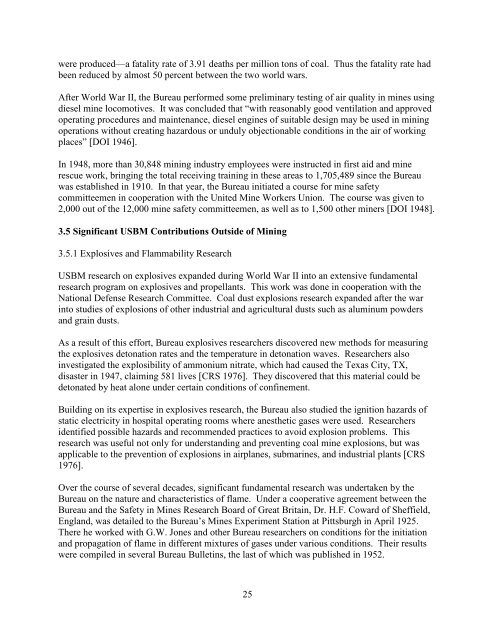One Hundred Years of Federal Mining Safety and Health Research
One Hundred Years of Federal Mining Safety and Health Research
One Hundred Years of Federal Mining Safety and Health Research
- No tags were found...
You also want an ePaper? Increase the reach of your titles
YUMPU automatically turns print PDFs into web optimized ePapers that Google loves.
were produced—a fatality rate <strong>of</strong> 3.91 deaths per million tons <strong>of</strong> coal. Thus the fatality rate had<br />
been reduced by almost 50 percent between the two world wars.<br />
After World War II, the Bureau performed some preliminary testing <strong>of</strong> air quality in mines using<br />
diesel mine locomotives. It was concluded that “with reasonably good ventilation <strong>and</strong> approved<br />
operating procedures <strong>and</strong> maintenance, diesel engines <strong>of</strong> suitable design may be used in mining<br />
operations without creating hazardous or unduly objectionable conditions in the air <strong>of</strong> working<br />
places” [DOI 1946].<br />
In 1948, more than 30,848 mining industry employees were instructed in first aid <strong>and</strong> mine<br />
rescue work, bringing the total receiving training in these areas to 1,705,489 since the Bureau<br />
was established in 1910. In that year, the Bureau initiated a course for mine safety<br />
committeemen in cooperation with the United Mine Workers Union. The course was given to<br />
2,000 out <strong>of</strong> the 12,000 mine safety committeemen, as well as to 1,500 other miners [DOI 1948].<br />
3.5 Significant USBM Contributions Outside <strong>of</strong> <strong>Mining</strong><br />
3.5.1 Explosives <strong>and</strong> Flammability <strong>Research</strong><br />
USBM research on explosives exp<strong>and</strong>ed during World War II into an extensive fundamental<br />
research program on explosives <strong>and</strong> propellants. This work was done in cooperation with the<br />
National Defense <strong>Research</strong> Committee. Coal dust explosions research exp<strong>and</strong>ed after the war<br />
into studies <strong>of</strong> explosions <strong>of</strong> other industrial <strong>and</strong> agricultural dusts such as aluminum powders<br />
<strong>and</strong> grain dusts.<br />
As a result <strong>of</strong> this effort, Bureau explosives researchers discovered new methods for measuring<br />
the explosives detonation rates <strong>and</strong> the temperature in detonation waves. <strong>Research</strong>ers also<br />
investigated the explosibility <strong>of</strong> ammonium nitrate, which had caused the Texas City, TX,<br />
disaster in 1947, claiming 581 lives [CRS 1976]. They discovered that this material could be<br />
detonated by heat alone under certain conditions <strong>of</strong> confinement.<br />
Building on its expertise in explosives research, the Bureau also studied the ignition hazards <strong>of</strong><br />
static electricity in hospital operating rooms where anesthetic gases were used. <strong>Research</strong>ers<br />
identified possible hazards <strong>and</strong> recommended practices to avoid explosion problems. This<br />
research was useful not only for underst<strong>and</strong>ing <strong>and</strong> preventing coal mine explosions, but was<br />
applicable to the prevention <strong>of</strong> explosions in airplanes, submarines, <strong>and</strong> industrial plants [CRS<br />
1976].<br />
Over the course <strong>of</strong> several decades, significant fundamental research was undertaken by the<br />
Bureau on the nature <strong>and</strong> characteristics <strong>of</strong> flame. Under a cooperative agreement between the<br />
Bureau <strong>and</strong> the <strong>Safety</strong> in Mines <strong>Research</strong> Board <strong>of</strong> Great Britain, Dr. H.F. Coward <strong>of</strong> Sheffield,<br />
Engl<strong>and</strong>, was detailed to the Bureau’s Mines Experiment Station at Pittsburgh in April 1925.<br />
There he worked with G.W. Jones <strong>and</strong> other Bureau researchers on conditions for the initiation<br />
<strong>and</strong> propagation <strong>of</strong> flame in different mixtures <strong>of</strong> gases under various conditions. Their results<br />
were compiled in several Bureau Bulletins, the last <strong>of</strong> which was published in 1952.<br />
25
















